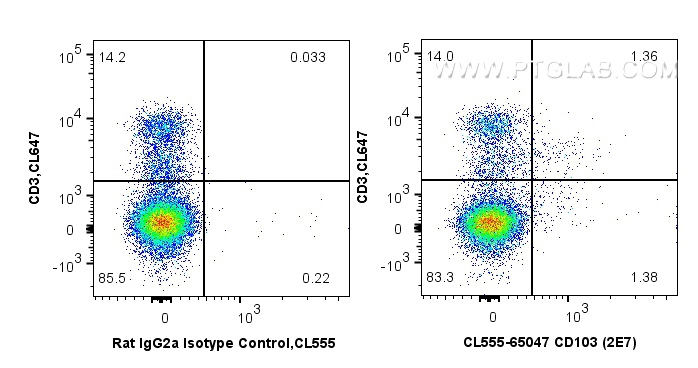验证数据展示
经过测试的应用
| Positive FC detected in | mouse splenocytes |
推荐稀释比
| 应用 | 推荐稀释比 |
|---|---|
| This reagent has been tested for flow cytometric analysis. It is recommended that this reagent should be titrated in each testing system to obtain optimal results. | |
| Sample-dependent, Check data in validation data gallery. | |
产品信息
CL555-65047 targets CD103 in FC applications and shows reactivity with Mouse samples.
| 经测试应用 | FC Application Description |
| 经测试反应性 | Mouse |
| 免疫原 | C57BL/6J mouse intestinal intraepithelial lymphocytes (IEL) 种属同源性预测 |
| 宿主/亚型 | Hamster / IgG |
| 抗体类别 | Monoclonal |
| 产品类型 | Antibody |
| 全称 | integrin alpha E, epithelial-associated |
| 别名 | A530055J10, alpha E1, alpha M290, aM290, CD103, Itgae |
| GenBank蛋白编号 | BC150690 |
| 基因名称 | CD103 |
| Gene ID (NCBI) | 16407 |
| RRID | AB_3084536 |
| 偶联类型 | CoraLite® Plus 555 Fluorescent Dye |
| 最大激发/发射波长 | 554 nm / 570 nm |
| 形式 | Liquid |
| 纯化方式 | Affinity purification |
| UNIPROT ID | Q60677 |
| 储存缓冲液 | PBS with 0.09% sodium azide , pH 7.3 |
| 储存条件 | Store at 2-8°C. Avoid exposure to light. Stable for one year after shipment. |
背景介绍
CD103, also known as integrin alpha-E (ITGAE) or integrin alpha-IEL, is a type I transmembrane integrin protein that binds integrin beta 7 to form Integrin alpha-E beta-7 which is a receptor for E-cadherin and mediates adhesion of T lymphocytes to epithelial cells (PMID: 7969453; 8468482). CD103 is expressed on intraepithelial lymphocyte (IEL) T cells (both alpha/beta T cells and gamma/delta T cells), some peripheral regulatory T cells (Tregs), lamina propria T cells, and a subset of dendritic cells in the gut mucosa and mesenteric lymph nodes (PMID: 12242333; 15608520; 16216890).
实验方案
| Product Specific Protocols | |
|---|---|
| FC protocol for CL Plus 555 CD103 antibody CL555-65047 | Download protocol |
| Standard Protocols | |
|---|---|
| Click here to view our Standard Protocols |
